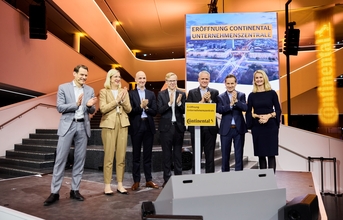
Continental officially opened its new corporate headquarters at a ceremony held in Hanover, Germany.
"We have created a place where our vision, values and culture can come alive in an open, connected and sustainable working environment. It is an expression of our sense of togetherness and a symbol of our long-term aspirations," said Continental CEO Nikolai Setzer at the opening ceremony.
Prominent representatives from business, politics and culture, including Lower Saxony's Minister President Stephan Weil and Hanover's mayor Belit Onay.
"The new corporate headquarters is a clear and architecturally impressive commitment from Continental to Lower Saxony and its state capital of Hanover. Continental is a strong and reliable business partner and an important employer in the region," remarked Minister President Weil.
The new Continental campus comprises six buildings. A prominent feature of the complex is a suspended bridge spanning 75 metres, which crosses Hans-Böckler-Allee to link the northern and southern parts of the campus.
The open-space concept fosters flexibility and agile collaboration
Since December 1, 2023, around 2,400 employees from the group functions as well as the Tyres and ContiTech group sectors have been working at the campus, an integrated open-space concept with areas for interaction and collaboration as well as quiet zones for focused work.
Instead of assigned workstations, employees can choose where they want to work using a desk booking system. "We chose the architecture with functionality in mind. It will enhance our performance and foster value creation," underscored Setzer.
New campus sets sustainability standards
The complex meets the German government's criteria for climate-friendly new buildings and, accordingly, the requirements for its sustainable building quality seal. Additional equipment and operating features make the new headquarters one of the most sustainable office buildings in Europe. The roofs of the parking garages, for example, are fitted with solar panels. Rainwater is collected, and a geothermal system harnesses the Earth's energy to heat and cool the building, largely covering its requirements. The green roof areas are also equipped with photovoltaic systems that generate up to 3,00,000 kilowatt hours of electricity a year, which is used, for example, to charge electric cars and bicycles at 100 charging points in the two parking garages.
When the open-plan office areas were designed, particular attention was paid to the use of natural materials such as wood, stone and natural fibres. Slatted ceilings and mobile partitions dampen acoustics to achieve a working environment that is both pleasant and sustainable.



























